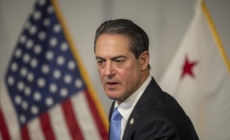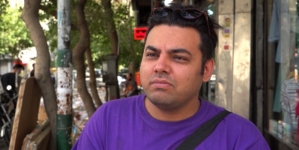-
Map Shows Timeline of Two New Tropical Storms - 12 mins ago
-
Orange County DA retaliated against female prosecutor, jury finds - 29 mins ago
-
Military parade in Washington, D.C., could disrupt flights at Reagan National Airport - 40 mins ago
-
Americans Filing for Social Security Surges to Record High Amid Cut Fears - 51 mins ago
-
With Aaron Rodgers, where do Steelers stand in AFC pecking order? - 54 mins ago
-
Torrance boy, 9, detained by ICE for planned deportation to Honduras; community outraged - about 1 hour ago
-
Florida man convicted in 2004 cold case death of victim whose remains have not been found - about 1 hour ago
-
‘Cheers’ actor George Wendt’s death linked to heart conditions - about 1 hour ago
-
Musk On If Trump Should Be Impeached: ‘Yes’ - about 1 hour ago
-
FOX Super 6 contest: Chris ‘The Bear’ Fallica’s Belmont Stakes picks - 2 hours ago
The Trevor Project: Research on LGBTQ Youth Faces ‘Perfect Storm’ Amid Trump Administration | Opinion
Research on LGBTQ young people in the United States has long fallen short. While important gains in data collection and scientific understanding of this historically under-represented group have been made in recent years, the federal government’s current and ongoing actions pose a direct threat to that progress. As we observe Mental Health Awareness Month this May, the research field faces new and deeply concerning challenges in understanding and responding to the public health crisis of suicide among LGBTQ youth in particular.
Hundreds of millions of dollars in federal funding for LGBTQ research have been slashed. It was most recently reported that nearly half of the National Institutes of Health (NIH) grants that have been canceled this month—partially or entirely—are related to LGBTQ health. This news also comes after alarming reports that leading U.S. government agencies, including the Centers for Disease Control and Prevention (CDC), have removed mentions of LGBTQ people and/or stopped collecting data on populations entirely.
Getty Images
With so many headlines to keep up with, these stories can easily get lost in the shuffle. But I am urging folks to consider their impacts. These decisions can take a drastic toll on the mental health of LGBTQ young people—and create devastating consequences for LGBTQ people in the U.S. for years to come.
To understand how these current government actions will impact the health and well-being of LGBTQ youth in the United States, it’s important to recognize the gaps in LGBTQ youth mental health research that existed before the current administration. One of the largest gaps was shockingly simple: historically, leading American public health institutions have failed to collect consistent data on sexual orientation and gender identity. This has meant that entire groups of young people—those who were already found to be at higher risk for suicide, depression, and anxiety—were effectively invisible in national surveys and research outputs.
Even when data did exist, most studies lacked nuance as they failed to reflect the full breadth of the LGBTQ community, overlooking how race, economic status, disability, and geography intersect with gender and sexuality. As a result, we missed critical insights—for instance, how the experience of a Black, nonbinary teenager living in a rural town might differ drastically from that of a white, gay teen from a major city.
In my 13 years as a researcher, I have regularly encountered potential funders, partners, and project managers who have feared that objective, scientific, and necessary work may be unfairly viewed as “political” simply because it focused on LGBTQ populations. But it must be made clear: research that studies the mental health of an at-risk population such as LGBTQ youth is not political. Rather, this type of work has become politicized by politicians and special interest groups who believe that understanding the realities and reasons associated with health disparities among LGBTQ populations will impact their political agenda, whatever it may be.
Efforts to politicize objective research on LGBTQ youth mental health are nothing new. However, what we are witnessing, right now, is an attempt to completely overhaul the U.S. research field to support a political agenda—not the advancement of science or the health of the nation. And that is dangerous.
Disagreements about specific policies or federal funding priorities are to be expected with new government leadership. However, we should all agree that following scientific best practices to research and understand high risk groups—especially when addressing an urgent public health crisis like suicide—is a worthwhile pursuit. Politics should not prevent researchers from being able to collect and analyze data that inform life-saving interventions.
LGBTQ young people are more than four times as likely to attempt suicide than their peers, and The Trevor Project estimates that every 45 seconds, at least one LGBTQ young person in the U.S. attempts to take their own life. Research shows that there is nothing about being LGBTQ that puts a young person at risk, but rather, we observe these heightened rates because of how they are mistreated by others. Whether it’s anti-LGBTQ bullying, or feeling that they do not have support at home, or the volume of anti-LGBTQ laws and political rhetoric, there are far too many compounding mental health risk factors being hurled at LGBTQ youth across the U.S. To better understand and address this crisis among young Americans, we need to conduct more research—not less.
The LGBTQ community in the United States cannot—and will not—ever be erased. Though, this community certainly deserves to be counted accurately and consistently, and included by the country’s leading health and scientific authorities. I am urging the federal government to put politics aside and show a willingness to simply conduct the research we need to support LGBTQ young people’s health and well-being—and to save their lives.
Dr. Ronita Nath is the vice president of research at The Trevor Project.
The views expressed in this article are the writer’s own.
Source link





























